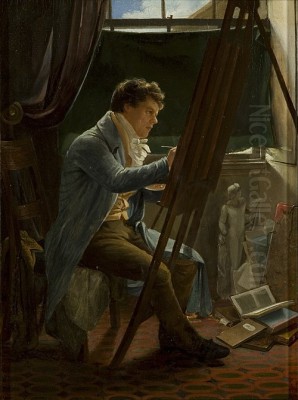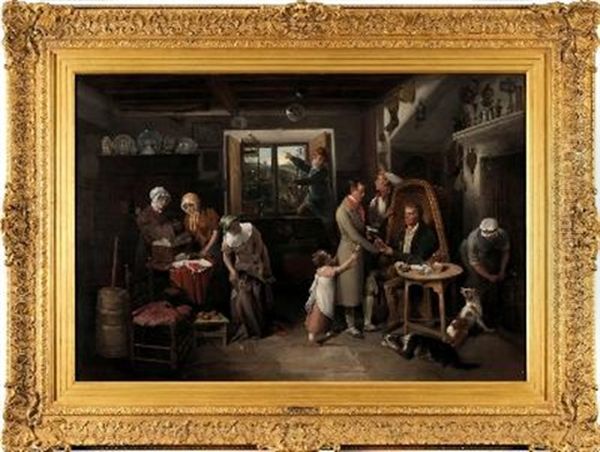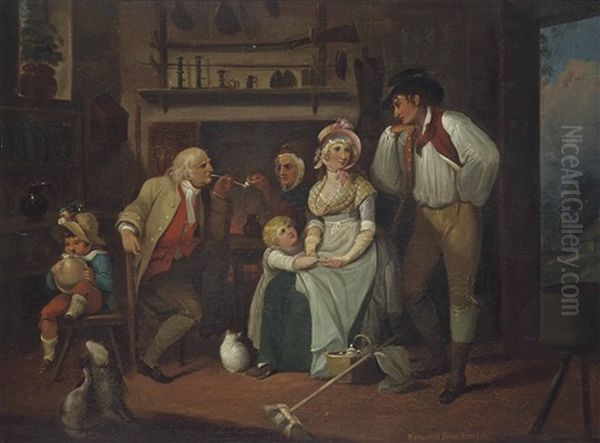
Edward Bird, a prominent figure in the British art scene of the late 18th and early 19th centuries, carved a unique niche for himself as a painter of genre scenes, historical subjects, and, to a lesser extent, portraits. Born in an era of significant social and artistic change, Bird's work captured the nuances of everyday life with a warmth and humour that resonated with his contemporaries, while his historical paintings engaged with the grand narratives of his time. Though his fame may have been somewhat eclipsed by other luminaries, his contributions to the Bristol School and his brief but notable challenge to the dominance of genre painting in London secure his place in the annals of British art history.
Early Life and Artistic Awakening
Edward Bird was born on April 12, 1772, in Wolverhampton, Staffordshire, a town then burgeoning with the early stirrings of the Industrial Revolution. His father, a clothier by trade, was described as a man of good understanding and character, who ensured his son received a respectable education. From a very tender age, Bird exhibited an irrepressible passion for drawing. Anecdotes from his childhood suggest that his artistic inclinations were apparent almost as soon as he could hold a pencil. It is said that he would rise early, even before dawn, to sketch on any available surface, much to the occasional exasperation of his family, as furniture and walls often bore the marks of his youthful creativity.
This innate talent did not go unnoticed. By the age of fourteen, Bird had already produced his first work of some note, a composition depicting a fictional meeting between Mary, Queen of Scots, and the Earl of Lincoln, inspired by a literary source. While his father was supportive of his artistic pursuits, the practicalities of life dictated a more conventional path. Consequently, young Edward was apprenticed to a tea-tray manufacturer in nearby Birmingham. This trade, often involving the intricate art of "japanning" – lacquering and decorating metalware with elaborate designs – likely provided him with valuable skills in detailed work, composition, and the application of colour, even if it wasn't fine art in the academic sense.

Despite this commercial apprenticeship, Bird's artistic ambitions remained undiminished. He continued to hone his skills, and eventually, the pull of a more independent artistic career led him to Bristol. This bustling port city, with its vibrant cultural life, would become the primary locus of his artistic development and success.
The Bristol Years and the Rise of a Genre Painter
Upon relocating to Bristol, Edward Bird initially established himself by opening a drawing school and undertaking decorative work. He produced a variety of sketches, caricatures, and small compositions, demonstrating a keen eye for human character and a burgeoning sense of humour. These early endeavours helped him build a reputation within the local community and provided a foundation for his more ambitious artistic projects.
It was in Bristol that Bird truly began to flourish as a painter. He was largely self-taught in the higher branches of art, relying on his own observations, diligent practice, and the study of works by other artists. Around the age of thirty, a significant journey to London allowed him to immerse himself in the masterpieces of historical painting. He reportedly studied works depicting grand themes such as "The Sufferings of Job," "The Death of Sapphira," "The Death of Eli," and "The Burning of Ridley and Latimer." This exposure undoubtedly broadened his artistic horizons and fueled his ambition to tackle more complex and serious subjects.
Initially, he focused on religious scenes, often executed in pencil, before transitioning to oil painting. However, it was his genre paintings – depictions of everyday life and common people – that first brought him widespread recognition. These works were characterized by their narrative clarity, sympathetic portrayal of human emotions, and often, a gentle, observational humour. His style in this domain was significantly influenced by the Dutch and Flemish masters of the 17th century, such as David Teniers the Younger and Adriaen Brouwer, whose works were highly prized by British collectors.
Bird's development as a genre painter also occurred in the context of a burgeoning British school of genre painting, most famously championed by the Scottish artist Sir David Wilkie. Wilkie's meticulously detailed and engaging scenes of rural and domestic life had captivated the London art world, and Bird emerged as a significant talent working in a similar vein, albeit with his own distinct regional flavour and perhaps a softer, less overtly moralizing tone than some of his predecessors like William Hogarth.
Artistic Style and Influences

Edward Bird's artistic style is most readily associated with genre painting, where he excelled in capturing the small dramas and comedies of ordinary existence. His approach was marked by careful observation, an ability to render character and expression effectively, and a talent for composing multi-figure scenes that told a clear story. His colour palette was generally warm and harmonious, and his brushwork, while not as minutely detailed as some of his Dutch antecedents, was proficient and expressive.
The influence of 17th-century Dutch and Flemish art is undeniable. Artists like Jan Steen, with his lively and often chaotic domestic interiors, or Adriaen van Ostade, with his depictions of peasant life, provided models for the subject matter and compositional strategies that Bird adapted. He shared their interest in the anecdotal, the humorous, and the sentimental aspects of human experience.
A more direct contemporary influence and, at times, a rival, was Sir David Wilkie. Wilkie's success with works like "The Village Politicians" and "The Blind Fiddler" had set a high standard for genre painting in Britain. Bird's work often invited comparison with Wilkie's, and for a period, he was seen as a genuine challenger to Wilkie's preeminence. While both artists drew from similar Netherlandish sources, Bird's scenes often possessed a slightly different sensibility, perhaps less focused on rustic poverty and more on the domestic lives of a slightly more comfortable, though still ordinary, class.
Beyond genre, Bird also ventured into historical painting, particularly scenes from British history and contemporary events, such as the Napoleonic Wars. In these works, he aimed for a greater sense of drama and gravitas, though his natural inclination towards narrative and human interest remained evident. The influence of earlier British historical painters like Benjamin West and John Singleton Copley, who had established a tradition of depicting grand historical and modern events, can be discerned in Bird's ambitions in this field. Furthermore, the sentimental and moralizing tendencies found in the work of French artists like Jean-Baptiste Greuze also found an echo in some of Bird's more emotionally charged compositions.
William Hogarth, the great 18th-century satirist and narrative painter, also cast a long shadow over British art. While Bird's humour was generally gentler and less biting than Hogarth's, the older master's legacy of using art to comment on social manners and human foibles was part of the artistic environment in which Bird operated.
Key Works and Thematic Concerns
Several of Edward Bird's paintings stand out as representative of his talent and thematic preoccupations. In the realm of genre, "Good News," exhibited in 1808, was a significant success. The painting depicts the interior of a humble dwelling where an old soldier, a Chelsea Pensioner, reacts with patriotic fervour to the news of a British victory, likely during the Napoleonic Wars. The varied reactions of the other figures – the eager attention of the younger man reading the gazette, the concern of the women – create a vivid and emotionally resonant scene. This work showcased Bird's ability to capture a moment of national significance through the lens of individual experience.
Another highly regarded genre piece was "The Reading of the Will Concluded," exhibited in 1811. This painting delves into the complex emotions and social dynamics that unfold after the formal reading of a last testament. The varied expressions of hope, disappointment, greed, and sorrow among the assembled family members and acquaintances are skillfully portrayed, offering a subtle commentary on human nature and the social rituals surrounding death and inheritance. It reflects an interest in the interior lives and moral dimensions of his subjects, a common thread in British art of the period.
"Departure for London," painted in 1815, is another poignant example of Bird's focus on domestic themes. It captures the emotional moment of a young person leaving home to seek their fortune in the capital, a common experience in an era of increasing social mobility. The tender farewells, the anxieties of the parents, and the hopeful anticipation of the departing youth are rendered with sensitivity and warmth, making the scene relatable and touching.
Beyond these intimate genre scenes, Bird also tackled more ambitious historical subjects. His painting "The Embarkation of Louis XVIII at Dover" commemorated the restoration of the French monarchy after Napoleon's abdication. This work, aligning with the prevailing political sentiments in Britain, demonstrated his capacity to handle large-scale compositions with numerous figures and to engage with contemporary historical events of international importance. He was also known for portraits, such as that of "Sir Charles Elton," which would have been an important source of income and local prestige.
A recurring characteristic in many of Bird's genre works is a gentle humour and an appreciation for the simple pleasures and trials of family life. His paintings often convey a sense of community and shared experience, whether it's the excitement of news, the solemnity of a will reading, or the bittersweetness of a departure.
Royal Patronage and Recognition at the Royal Academy
Edward Bird's growing reputation did not go unnoticed beyond Bristol. He began exhibiting his works at the prestigious Royal Academy of Arts in London, the epicentre of the British art world. His submissions were generally well-received, and he was praised for his originality, his humour, and his skillful depiction of domestic scenes. In 1812, he was elected an Associate of the Royal Academy (A.R.A.), a significant mark of recognition from his peers. Just three years later, in 1815, he achieved the distinction of being elected a full Royal Academician (R.A.), cementing his status as one of the leading artists of his day.
This period marked the zenith of his career. His success in London was such that, for a time, he was considered a serious rival to Sir David Wilkie in the field of genre painting. This was no small feat, given Wilkie's immense popularity and critical acclaim. Bird's ability to connect with the public through his relatable and often amusing scenes contributed significantly to his rise.
Further enhancing his prestige, Bird received royal patronage. He was appointed "Historical Painter to Her Royal Highness Princess Charlotte Augusta of Wales." Princess Charlotte was the only child of the Prince Regent (later King George IV) and was, for a time, the heir presumptive to the British throne. Such an appointment was a considerable honour and would have provided Bird with opportunities for important commissions, including the aforementioned "Embarkation of Louis XVIII," which celebrated a key moment in the post-Napoleonic political landscape. This royal connection underscored his standing in the national art scene.
His regular participation in the Royal Academy's annual exhibitions ensured that his work was seen by a wide audience, including influential critics, collectors, and fellow artists such as J.M.W. Turner and John Constable, who were also shaping the course of British art, albeit primarily in landscape painting. Other prominent figures in the Academy at the time included portraitists like Sir Thomas Lawrence and historical painters like Henry Fuseli.
The Bristol School and Interaction with Contemporaries
While Bird achieved national recognition, his roots remained firmly in Bristol, where he was a central figure in what became known as the Bristol School. This informal group of artists, active in the early 19th century, shared an interest in landscape painting, often inspired by the picturesque scenery around Bristol, as well as genre subjects. Bird's studio became a meeting place for local artists and intellectuals.
Among his close associates in Bristol was George Cumberland (1754-1848), a writer, collector, and amateur artist who was an important friend and patron to Bird. Cumberland was a man of wide-ranging intellectual interests and a correspondent of William Blake. He encouraged Bird and other Bristol artists to study nature directly and was a supportive presence in the local artistic community. The plein air sketching excursions, where artists would paint outdoors to capture the fleeting effects of light and atmosphere, were a feature of the Bristol School's activities, though Bird himself was more known for his figure compositions.
Other artists associated with the Bristol School, though perhaps more focused on landscape, included Francis Danby, Samuel Jackson, and James Johnson. Bird's success as a figure painter and Royal Academician would have lent considerable prestige to this regional artistic circle. His teaching activities in Bristol also meant that he directly influenced a younger generation of artists.
His relationship with Sir David Wilkie was complex, marked by both rivalry and mutual respect, typical of artists working in similar fields. While Bird's London successes were notable, Wilkie's sustained output and powerful patronage network ultimately secured him a more dominant and lasting position in the history of British genre painting. Nevertheless, Bird's challenge was significant enough to be remarked upon by contemporary critics.
Bird's work also existed within a broader European context. The taste for sentimental genre, popularized by artists like Jean-Baptiste Greuze in France, had an international appeal, and Bird's emotionally engaging scenes tapped into this sensibility. Similarly, the tradition of social commentary through art, famously exemplified by William Hogarth in Britain, provided a backdrop for artists depicting contemporary life and manners.
Later Years, Declining Health, and Legacy
Despite his successes and his election as a Royal Academician, Edward Bird's later years were marked by declining health and, according to some accounts, a waning of his popular acclaim. The reasons for this are not entirely clear, but changing artistic tastes and the persistent brilliance of rivals like Wilkie may have played a part. He reportedly suffered from periods of depression and ill health, which inevitably impacted his productivity and his ability to maintain his high profile in the competitive London art world.
His focus also began to shift more towards historical subjects in his later career, perhaps in an attempt to secure a different kind of artistic reputation, or possibly due to commissions like the one from Princess Charlotte. While these historical works were ambitious, they did not always achieve the same popular resonance as his earlier genre scenes, which were celebrated for their intimacy and humour.
Edward Bird passed away on November 2, 1819, in Bristol, at the relatively young age of 47. He was buried in Bristol Cathedral, a mark of the esteem in which he was held in the city that had been his home and the centre of his artistic life for so many years.
In the immediate aftermath of his death, his reputation somewhat faded. The art world continued to evolve, and new talents and trends emerged. However, Edward Bird's contribution remains significant. He was a key figure in the development of British genre painting, producing works that were both popular and critically respected. He demonstrated that an artist based primarily outside London could achieve national recognition and play a role in shaping artistic discourse.
His role in the Bristol School was also crucial, fostering a supportive environment for artists in the region. His paintings provide valuable insights into the social customs, sentiments, and everyday life of early 19th-century Britain. Works like "Good News" and "The Reading of the Will" continue to be appreciated for their narrative skill, psychological acuity, and historical interest.
Conclusion: Reassessing Edward Bird
Edward Bird, R.A., stands as an accomplished and engaging painter whose work offers a window into the Britain of his time. From his early artistic stirrings in Wolverhampton to his establishment as a leading figure in Bristol and his successes on the London stage, Bird's career reflects a dedication to capturing the human condition, whether in the grand sweep of history or the intimate moments of domestic life.
Influenced by the rich tradition of Dutch and Flemish masters, and a contemporary of giants like Wilkie, Turner, and Constable, Bird carved out his own distinct artistic identity. His genre scenes, imbued with warmth, humour, and keen observation, resonated deeply with the public and earned him a place in the Royal Academy. His historical paintings engaged with the significant events and figures of his era, reflecting his ambition and versatility.
Though perhaps not as universally renowned today as some of his contemporaries, Edward Bird's legacy endures through his charming and insightful paintings, his contribution to the Bristol School, and his role in the flourishing of British art in the early 19th century. He remains a testament to the enduring appeal of art that speaks to shared human experiences with skill, empathy, and a touch of wit. His work invites us to look closer at the lives and times he depicted, reminding us of the rich tapestry of stories that make up our collective past.